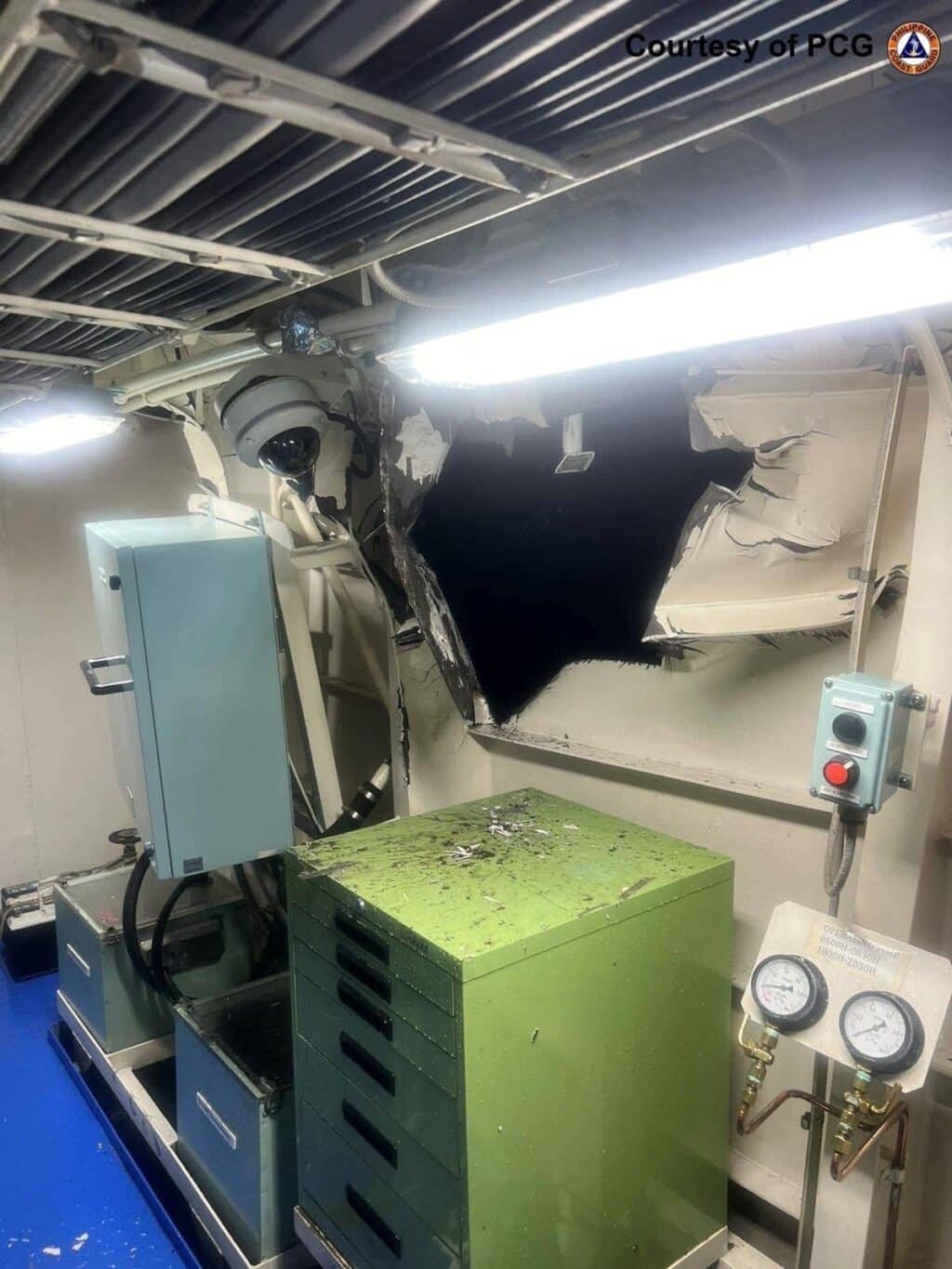China, Philippine trade blame on ship collision

A photo of the damage sustained by MRRV-4410 after a reported collision with a Chinese vessel on Monday morning, August 19. | Photo from PCG via PIA
TAIPEI, Taiwan— Chinese and Philippine coast guard ships collided at sea, damaging at least two boats, in an encounter early Monday, August 19, 2024, near a new flashpoint in their increasingly alarming confrontations in the disputed South China Sea.
Both blamed the other for the collision near Sabina Shoal, a disputed atoll in the Spratly Islands, where overlapping claims are also made by Vietnam and Taiwan. There were no reports of injuries.
China’s coast guard accused the Philippines of deliberately crashing one of its ships into a Chinese vessel. Two Philippine coast guard ships entered waters near the shoal, ignored the Chinese coast guard’s warning and intentionally collided with one of China’s boats at 3:24 a.m., a spokesperson said in a statement on the Chinese coast guard’s website.
READ MORE:
Chinese, Philippine ships ‘collided’ in disputed South China Sea, Beijing says
“The Philippine side is entirely responsible for the collision,” spokesman Gan Yu said. “We warn the Philippine side to immediately stop its infringement and provocation, otherwise it will bear all the consequences arising from that.”
The Philippines’ National Task Force on the West Philippine Sea said two of the coast guard’s ships, BRP Bagacay and BRP Cape Engaño, “encountered unlawful and aggressive maneuvers” from Chinese coast guard vessels while en route to Patag and Lawak islands in the area.
“These dangerous maneuvers resulted in collisions, causing structural damage to both Philippine Coast Guard vessels,” the statement read.
The task force said the collision between BRP Cape Engaño and one of the Chinese ships created a hole on the deck of the Philippine ship with a diameter of about 5 inches (12.7 centimeters).
About 16 minutes later, the other Philippine ship, BRP Bagacay, was rammed twice on its port and starboard sides by a different Chinese vessel, leading to minor structural damage, according to the task force.
“The (Philippine Coast Guard) stands firm in its responsibility to ensure the safety and security of our maritime domain while addressing any threats to our national interests,” it said.
Gan added China claimed “indisputable sovereignty” over the Spratly Islands, known in Chinese as Nansha Islands, including Sabina Shoal and its adjacent waters. The Chinese name for Sabina Shoal is Xianbin Reef.
In a separate statement, he said the Philippine ship that was turned away from Sabina Shoal entered waters near the disputed Second Thomas Shoal, ignoring the Chinese coast guard’s warnings. “The Chinese coast guard took control measures against the Philippine ship in accordance with law and regulation,” he added.
Sabina Shoal, which lies about 140 kilometers (87 miles) west of the Philippines’ western island province of Palawan, has become a new flashpoint in the territorial disputes between China and the Philippines.
The Philippine coast guard deployed one of its key patrol ships, the BRP Teresa Magbanua, to Sabina in April after Filipino scientists discovered submerged piles of crushed corals in its shallows that sparked suspicions that China may be bracing to build a structure in the atoll. The Chinese coast guard later deployed a ship to Sabina.
Sabina lies near the Philippine-occupied Second Thomas Shoal, which has been the scene of increasingly alarming confrontations between Chinese and Philippine coast guard ships and accompanying vessels since last year.
China and the Philippines reached an agreement last month to prevent further confrontations when the Philippines transports new batches of sentry forces, along with food and other supplies, to Manila’s territorial outpost in the Second Thomas Shoal, which has been closely guarded by Chinese coast guard, navy and suspected militia ships.
The Philippine navy transported food and personnel to the Second Thomas Shoal a week after the deal was reached and no incident was reported, sparking hope that tensions in the shoal would eventually ease.
China has been at odds with many other countries in the Asia-Pacific for years over its sweeping maritime claims, including almost all of the South China Sea, a strategic and resource-rich waterway around which Beijing has drawn a 10-dash line on official maps to delineate what it says is its territory.
Beijing is in the midst of a massive military expansion and has become increasingly assertive in pursuing its claims, giving rise to more frequent direct confrontations, primarily with the Philippines, though it is also involved in longtime territorial disputes with Vietnam, Taiwan, Malaysia and Brunei.
A 2016 arbitration ruling by a United Nations tribunal invalidated Beijing’s claims in the South China Sea, but China did not participate in the proceedings and rejected the ruling.
Disclaimer: The comments uploaded on this site do not necessarily represent or reflect the views of management and owner of Cebudailynews. We reserve the right to exclude comments that we deem to be inconsistent with our editorial standards.
